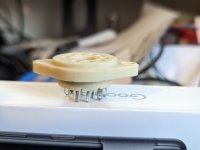hello Jose:
I would be inclined to mount them from below and put a rubber gasket/washer on each of the mounting screw. The gasket will allow a bit of flex, reduce tension on the ceramic and decouple the socket from the chassis. I would also "pre-stretch" the pin holes onto a tube before I tried to fit them once the sockets are mounted to the chassis to lower the risk of cracking the ceramic.
I hope this helps
I would be inclined to mount them from below and put a rubber gasket/washer on each of the mounting screw. The gasket will allow a bit of flex, reduce tension on the ceramic and decouple the socket from the chassis. I would also "pre-stretch" the pin holes onto a tube before I tried to fit them once the sockets are mounted to the chassis to lower the risk of cracking the ceramic.
I hope this helps
Just what we need - a bunch of precision machine shop work to make some stinking mounting holes.
Good suggestion, I'm planning to do that, also adding a rubber gasket as others recommended.Could you elongate the screw holes to accommodate those ridges? That would allow the socket body to be flush with the mounting surface.
All you need is a drill and a small file, I've done elongated holes before. No need for precision tools.Just what we need - a bunch of precision machine shop work to make some stinking mounting holes.
About pre-stretching, there is no need with the ones in my first post. With the Chinese ones, definitely!hello Jose:
I would be inclined to mount them from below and put a rubber gasket/washer on each of the mounting screw. The gasket will allow a bit of flex, reduce tension on the ceramic and decouple the socket from the chassis. I would also "pre-stretch" the pin holes onto a tube before I tried to fit them once the sockets are mounted to the chassis to lower the risk of cracking the ceramic.
I hope this helps
.. or a paper washer, with rubber there is shaky movement.... , also adding a rubber gasket ...
You are probably right, I'll try that, thanks!Could you take a flat file to the raised area around the holes and flatten them out?
Easier than machining elongated holes maybe.
Got a bunch of those, will try it too, thanks!
Yes, it's the standardized Magnoval pin diameter, vs. 1 mm for Novar (and Compactron) pins.I just measured the pins of a PL504, PL508 and 6P41S, all exactly the same at around 1.25mm.
Aren't these fibre washers? Anyway, I also think they're the best solution of all.
What about just drilling a hole of the raised areas' bigger diameter instead of elongated holes? Filing ceramics is a tedious job and requires diamond instead of steel files. A real PITA!Could you take a flat file to the raised area around the holes and flatten them out?
Easier than machining elongated holes maybe.
Best regards!
I just tried filing the protuberance in one side, worked pretty well with my cheap flat file 😉Yes, it's the standardized Magnoval pin diameter, vs. 1 mm for Novar (and Compactron) pins.
Aren't these fibre washers? Anyway, I also think they're the best solution of all.
What about just drilling a hole of the raised areas' bigger diameter instead of elongated holes? Filing ceramics is a tedious job and requires diamond instead of steel files. A real PITA!
Best regards!
Attachments
Probably. It is harder than aluminium or steel, but with a couple of minutes of effort it goes away.Maybe they have forgotten to bake the ceramic green body 😉 ?
Best regards!
- Home
- Amplifiers
- Tubes / Valves
- Mounting ceramic sockets
